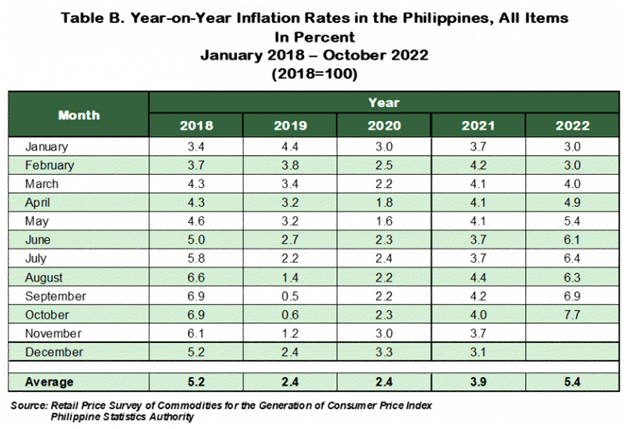PH Monday Macro: While the BSP manages inflation, take advantage of the opportunity in this crisis

With only weeks before the annual Christmas reunions and house parties come into full swing, we’re still dealing with high prices of goods and services due to both global and domestic supply chain issues.
While the Bangko Sentral ng Pilipinas (BSP), the Philippines’ central bank, has already expressed its intent to be aggressive in its planned rate price hikes, how high is it willing to go?
Philippine Markets Newsletter:
The Monday Macro Report
Powered by Valens Research
Inflation is all what people talk about these days, primarily because they’ve already been feeling the effect of the soaring prices of consumer goods. A running joke among Filipinos is we know inflation is real because 1 order of extra rice in the fast food chain costs PHP 32. That’s nearly the equivalent of an hour’s work for the minimum wage earner.
While the global supply chain issues pushed prices up earlier on, it’s also the local supply issues that have kept prices high. This is especially true with unresolved agriculture problems in a supposed agricultural country.
In August 2022, the price of white onions rose to around PHP 400 per kilo, mainly due to supply shortages as the harvest season had ended months before.
Prices of certain vegetables have also increased recently after Severe Tropical Storm Paeng hit the country over the October 29 to November 1 long weekend. According to the Department of Agriculture, about PHP 2.74 billion worth of farm produce was lost to that natural calamity.
Headline inflation at 7.7% for October 2022 is now the highest since December 2008. The BSP expects this to rise further in the next few months, and hopefully fall back to pre-2022 averages by mid-2023. Assuming there are no further shocks to the global economy and the global health environment, the central bank expects inflation to stabilize by 2024.
Food and non-alcoholic beverages grew by 9.4% in October 2022, higher than the 7.4% annual growth in September 2022. However, it’s not just food and energy items that are causing the elevated levels of inflation. Core inflation, which is calculated by taking headline inflation and removing food and energy, increased to 5.9% in October 2022, from 5.0% in September 2022 and just 2.5% in October 2021.
Though at a 14-year high of 7.7%, the latest inflation number is still within the BSP’s target range of 7.1% to 7.9% for October, albeit at the high end of expectations.
One of the tools in the central bank’s arsenal to keep the economy stable is interest rates. When inflation rate gets too high, the monetary authority hikes interest rates to manage the money supply in the economy.
In other words, if prices of goods get too high because of supply falling short of demand, the central bank will make saving money now more attractive to consumers by increasing interest rates.
Alternatively, if there is too much supply of goods and consumers are not as willing to spend, the central bank will lower interest rates to make spending now versus later on more attractive. This helps bring back consumer spending into the economy and keep inflation rates from falling.
It’s a balancing act that the BSP has to master in order to maintain acceptable levels of inflation in the country.
Amid the rising inflation rates, the BSP signaled it was prepared to match the US Federal Reserve’s aggressive movements in increasing interest rates.
So far, the BSP has increased rates by 225bps to 4.25% in 2022. It raised rates for the first time in May 2022 by 25bps, with another 25bps increase a month later. In the months after, the BSP took a more aggressive stance on interest rates as inflation continued to rise.
The central bank increased interest rates by 75bps in July 2022, 50bps in August 2022, and 50bps in September 2022. It is expected to increase interest rates by 75bps in November 2022, ending the year with a policy rate of 5.0%, the highest since 2009. It might even add another 50bps increase to the end of 2022 with 5.5% interest rates.
Now more than ever, it pays to take advantage of the opportunities that arise from crises.
About the Philippine Markets Newsletter
“The Monday Macro Report”
When just about anyone can post just about anything online, it gets increasingly difficult for an individual investor to sift through the plethora of information available.
Investors need a tool that will help them cut through any biased or misleading information and dive straight into reliable and useful data.
Every Monday, we publish an interesting chart on the Philippine economy and stock market. We highlight data that investors would normally look at, but through the lens of Uniform Accounting, a powerful tool that gets investors closer to understanding the economic reality of firms.
Understanding what kind of market we are in, what leading indicators we should be looking at, and what market expectations are, will make investing a less monumental task than finding a needle in a haystack.
Hope you’ve found this week’s macro chart interesting and insightful.
Stay tuned for next week’s Monday Macro report!
Regards,
Angelica Lim
Research Director
Philippine Markets Newsletter
Powered by Valens Research
www.valens-research.com





